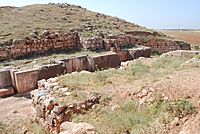Ebla tablets facts for kids
The Ebla tablets are a huge collection of ancient clay tablets. They were found in the ruins of the city of Ebla in Syria. There are about 1,800 whole tablets, plus thousands of broken pieces.
These tablets were discovered by an Italian archaeologist named Paolo Matthiae and his team. They found them in 1974 and 1975. The tablets were still on their shelves, just as they had fallen when the palace was destroyed. They even had clay tags to help people find them.
The tablets are very old, dating from around 2500 BC to 2250 BC. Today, you can see these amazing tablets in museums in the Syrian cities of Aleppo, Damascus, and Idlib.
Contents
Finding the Ancient Ebla Tablets
The Ebla tablets were found in a special room in "Palace G." They had fallen from their wooden shelves when the palace caught fire. This fire actually helped to bake and preserve the clay tablets, almost like they were put in a kiln.
The ancient scribes (people who wrote) had stored the tablets very neatly. They stood upright on shelves, tilted back so you could easily see the first words of each one. Small pieces of baked clay separated them. When the shelves burned, they collapsed, keeping the tablets in their original order. This made it easier for archaeologists to understand how they were organized.
Languages of the Ebla Tablets
The writing on the Ebla tablets used two different languages. One was Sumerian, which was already known. The other was a new language that nobody had seen before. This new language used the Sumerian cuneiform script (wedge-shaped writing) to write its own sounds.
At first, the expert who first read the tablets, Giovanni Pettinato, thought this new language was an early form of Canaanite. But he later changed his mind and called it "Eblaite," which is its name today.
Using Sumerian signs just for their sounds was a big step forward in the history of writing. It made writing simpler and easier to learn. This helped more people, like palace workers, temple staff, and traders, to read and write.
What the Ebla Tablets Tell Us
The Ebla tablets give us lots of information about Syria and Canaan during the early Bronze Age. They are the first known texts to mention "Canaanites," "Ugarit," and "Lebanon."
The tablets show that Ebla was a very important trading city. Many of them are economic records. They list Ebla's business deals and political connections with other cities. They also record what the city bought and sold. For example, the tablets show that Ebla made different kinds of beer, including one named after the city itself. Ebla also helped create a clever trading system that connected many cities in northern Syria.
The tablets also include lists of Ebla's kings, royal rules, and agreements with other places. There are lists of place names, like an old map. Some tablets contain stories, songs, and wise sayings.
Many tablets have both Sumerian and Eblaite writing. They include word lists that compare words in both languages. This has helped modern experts understand the Sumerian language better. Before these tablets were found, there were no dictionaries that translated Sumerian into other languages.
The Ebla archives also have thousands of student copybooks and practice tablets. This shows that Ebla was a major learning center. It was especially good at training scribes, who were the writers and record-keepers of that time.
Ebla and Ancient History
When the Ebla tablets were first found, some people thought they might prove stories from the Bible. For example, some wondered if the tablets mentioned people like Abraham or cities like Sodom and Gomorrah.
These ideas caused a lot of excitement, but also some arguments among experts. This was partly because it took a while for all the tablets to be fully published.
However, most experts today agree that the Ebla tablets do not directly confirm biblical stories. While they are very important for understanding the ancient world, their connection to the Bible is not as strong as some first thought.
See also



